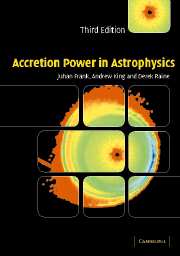Book contents
- Frontmatter
- Contents
- Preface to the first edition
- Preface to the second edition
- Preface to the third edition
- 1 ACCRETION AS A SOURCE OF ENERGY
- 2 GAS DYNAMICS
- 3 PLASMA CONCEPTS
- 4 ACCRETION IN BINARY SYSTEMS
- 5 ACCRETION DISCS
- 6 ACCRETION ON TO A COMPACT OBJECT
- 7 ACTIVE GALACTIC NUCLEI
- 8 ACCRETION DISCS IN ACTIVE GALACTIC NUCLEI
- 9 ACCRETION POWER IN ACTIVE GALACTIC NUCLEI
- 10 THICK DISCS
- 11 ACCRETION FLOWS
- Appendix: Radiation processes
- Problems
- Bibliography
- Index
Preface to the first edition
Published online by Cambridge University Press: 05 June 2012
- Frontmatter
- Contents
- Preface to the first edition
- Preface to the second edition
- Preface to the third edition
- 1 ACCRETION AS A SOURCE OF ENERGY
- 2 GAS DYNAMICS
- 3 PLASMA CONCEPTS
- 4 ACCRETION IN BINARY SYSTEMS
- 5 ACCRETION DISCS
- 6 ACCRETION ON TO A COMPACT OBJECT
- 7 ACTIVE GALACTIC NUCLEI
- 8 ACCRETION DISCS IN ACTIVE GALACTIC NUCLEI
- 9 ACCRETION POWER IN ACTIVE GALACTIC NUCLEI
- 10 THICK DISCS
- 11 ACCRETION FLOWS
- Appendix: Radiation processes
- Problems
- Bibliography
- Index
Summary
The subject of this book is astrophysical accretion, especially in those circumstances where accretion is believed to make an important contribution to the total light of an astrophysical system. Our discussion therefore centres mainly on close binary systems containing compact objects and on active nuclei. The reader is assumed to possess a basic knowledge of physics at first degree level, but only a rudimentary experience of astronomy is required. We have tried to concentrate on those features, particularly the basic physics, that are probably more firmly established; but the treatment is necessarily somewhat heterogeneous. For example, there is by now a tolerably coherent line of argument showing that the formation of an accretion disc is very likely in many close binaries, and giving a plausible picture of what such a disc is like, at least in some simple cases. In other areas, such as accretion on to the surface of a compact object, or in active nuclei, we are not so fortunate, and we must work back and forth between theory and observation. Our aim is that the book should provide a systematic introduction to the subject for graduate students. We hope it may also serve as a reference for interested astronomers in other fields, and that selected material will be suitable for undergraduate options in astronomy.
In Chapters 2 and 3 we present introductory material on fluid dynamics and plasma physics. Many excellent texts exist in these areas, but they tend to be too detailed for our needs; we have tried to extract just those basic ideas necessary for the subsequent discussion, and to set them in an astrophysical context.
- Type
- Chapter
- Information
- Accretion Power in Astrophysics , pp. ix - xPublisher: Cambridge University PressPrint publication year: 2002



